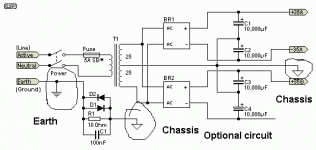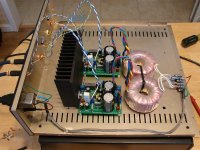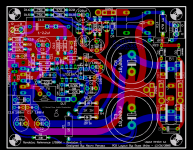What about power supply ground..😕
In your picture there is Earth and Chassis. You can see that the DC breaker circuit is optional.
The pwr supply grnd connection is to chassis grd and is dependent on the pwr supply. In your picture it does need to be connected to chassis ground, but a 2 pole pwr corded device does not require it.
Attachments
Last edited:
your interpretation seems to be different from the majority who have expressed an opinion.
Signal ground does not NEED to be connected to Earth or chassis ground. Emphasis is on NEED. Circuits can run without it.
OPINIONS vary on how it is implemented, but it is not REQUIRED.
As I also mentioned in my first post on the topic, even top designers such as Mr. Pass DO tie them together and the example was using a CL-60 as the tie component.
I do not think at any point I gave MY OPINION on the matter. But since I bring it up now, MY OPINION, it is:
Audio Control and Rane's EXCELLENT documents on ground and grounding. If you follow their documents on grounding I know of no better way to prevent or solve it.
of course circuits will work without the amplifier grounds connected to the Safety Earth.Signal ground does not NEED to be connected to Earth or chassis ground. Emphasis is on NEED. Circuits can run without it.
That is not the issue.
The real issue is whether the operator can safely use equipment that has exposed conductive parts not connected to Safety Earth and then becomes faulty, a spilt drink as an instance.
of course circuits will work without the amplifier grounds connected to the Safety Earth.
That is not the issue.
The real issue is whether the operator can safely use equipment that has exposed conductive parts not connected to Safety Earth and then becomes faulty, a spilt drink as an instance.
@ Andrew-
Define the grouping of "amplifier grounds"?
There are three or four grounds in analog equipment.
Earth, chassis, signal and depending on power supply used, power supply ground.
By MOST country safety codes and common sense (which varies by person) ONLY signal ground is optional.
@ All-
Back to relevancy, THIS amplifier, Mauro My Ref. Rev_C, does NOT REQUIRE a signal OR power ground attached to chassis ground. However, if you have hum or noise in **YOUR** amplifier, if you follow the Audio Control and Rane grounding guides it should be overcome.
**YOUR** meaning the one you built.
Commenting on general safety guidelines is great and benefits many. Commenting on SPECIFICS of amplifiers and circuits that you have not built or tested is questionable.
Attachments
let's get personal then.
Why do you think that a Signal Ground does not NEED to be connected to the Safety Earth?
Is it because you can never attach an interconnect to the input and ask your 9month old child to suck on the other end to stop him/her crying?
Whereas you say that "There are three or four grounds in analog equipment.
Earth, chassis, signal and depending on power supply used, power supply ground" and these must by most countries' codes be connected to Safety Earth?
Why do you think they should be treated differently?
The Signal Ground can be just as much a hazard as any of the others, maybe more so, since it more usually has an exposed conductive part.
Why do you think that a Signal Ground does not NEED to be connected to the Safety Earth?
Is it because you can never attach an interconnect to the input and ask your 9month old child to suck on the other end to stop him/her crying?
Whereas you say that "There are three or four grounds in analog equipment.
Earth, chassis, signal and depending on power supply used, power supply ground" and these must by most countries' codes be connected to Safety Earth?
Why do you think they should be treated differently?
The Signal Ground can be just as much a hazard as any of the others, maybe more so, since it more usually has an exposed conductive part.
@ Andrew-
Other than addressing a question to you there were no personal statements or attacks.
Have a nice day.
Other than addressing a question to you there were no personal statements or attacks.
Have a nice day.
Why don't we *not* get personal? Agree to disagree, anyone who's curious can look up more info elsewhere, and meanwhile there aren't 5 more pages added between the last on topic post and the next.
Off course, it doesn't need it to run. The chassis doesn't need neither be grounded. In fact, It will be more trouble-free regarding noise to not earth-ground audio ground. But we are talking about security issues.Signal ground does not NEED to be connected to Earth or chassis ground. Emphasis is on NEED. Circuits can run without it.
OPINIONS vary on how it is implemented, but it is not REQUIRED.
How would yo be protected from binding posts if you don't put them to ground?
Is it not a requirement to sound, it is as requirement if you want to be protected. It is not to fix hum problems, it is to fix security problems.
As Andrew said, what happens if live touches only a binding post and then your child touchs it?
here, I am opening correspondence with Troystg,
We can continue this away from the thread until we are satisfied with our conclusion and come back with an agreed safety regime.
PM to Troystg
We can continue this away from the thread until we are satisfied with our conclusion and come back with an agreed safety regime.
PM to Troystg
Hi,
are you afraid to respond to those questions when they are directed to you alone?
I responded when you directed the questions to me alone.
regards
Andrew T.
Copy to the thread.
I think this topic is too important to simply disagree. I do not believe we can leave two pieces of clearly opposite advice for any beginner (or less so) to pick up and decide which to follow.Why don't we *not* get personal?
Troystg put forward his view, I put forward my view. He got personal, possibly hoping I would back down by challenging me directly.
I responded pointing out that he had made it personal. Note the "then" making it a response to his challenge.
If I am wrong I will back off and let Troystg have the last word.
However I have made dozens of similar posts with the same advice in many other Threads. It will be difficult to identify all and ask the Moderators to remove 100%, but that is something I will have to consider.
This is simply for the benefit of the Community. It is not for me. I know what I am doing and I recognise when I am out of my depth and know when to ask for help.
Shark, you could do this other approach too. Is in the bottom of the page, where it does say "Use of loop breaker circuits". My 2 cents.
Earthing (Grounding) Your Hi-Fi - Tricks and Techniques
Earthing (Grounding) Your Hi-Fi - Tricks and Techniques
Shark, you could do this other approach too. Is in the bottom of the page, where it does say "Use of loop breaker circuits". My 2 cents.
Earthing (Grounding) Your Hi-Fi - Tricks and Techniques
Nice one Regi..🙂
Grounding and Shielding Audio Devices <-- of particular interest.... It clearly states that there SHOULD be a connection between audio ground and chassis ground. However it is up to the designer to decide where. Mauro did not choose that route in his design, instead he did signal ground referencing power ground.
Sound System Interconnection
http://www.rane.com/pdf/compgrou.pdf
And 12 volt references:
https://myeporia.eporia.com/resources/company_38/tech note 1002.pdf
Sound System Interconnection
http://www.rane.com/pdf/compgrou.pdf
And 12 volt references:
https://myeporia.eporia.com/resources/company_38/tech note 1002.pdf
OK, then we agree that for a safe system, you should connect audio ground and chassis ground (which in turn is PROTECTIVE EARTH from the IEC input). You can connect it in multiples places to Protective Earth, but at least one.Grounding and Shielding Audio Devices <-- of particular interest.... It clearly states that there SHOULD be a connection between audio ground and chassis ground. However it is up to the designer to decide where.
After that, you say that Mauro refuses to the previous statement, that he connect his amps to OTHER grounds he prefer. That is not in compliance with the previous "law" (sorry for the expresion) that you said and both agreed.
Regards,
Regi
Mauro did not choose that route in his design, instead he did signal ground referencing power ground.
OK, then we agree that for a safe system, you should connect audio ground and chassis ground (which in turn is PROTECTIVE EARTH from the IEC input). You can connect it in multiples places to Protective Earth, but at least one.
I said no such thing. The article I referenced said you "should" (edit: and not HAVE to). And it has changed from the 90's when I first read it saying "it doesn't matter".
After that, you say that Mauro refuses to the previous statement, that he connect his amps to OTHER grounds he prefer. That is not in compliance with the previous "law" (sorry for the expresion) that you said and both agreed.
Again I said no such thing. Mauro was the designer and he "OPT'ed" to design the system that way. There are no "Laws" to prohibit it. His design works and his IP should be honored and not deviated from without permission.
If you read me carefully, you will realize that I said "should" too and that I understood the exact meaning in that contest.I said no such thing. The article I referenced said you "should" (edit: and not HAVE to). And it has changed from the 90's when I first read it saying "it doesn't matter".
Wrong. There are laws against that, if you want it to be a consumer product (All exposed conductive parts...bla..bla..bla). I am assuming that I am a consumer because I use products, made or not by myself. There is no difference between both when they are up and working on my shelf. So, I cannot accept lower security requirements for the products that I made by myself, for myself, than from the ones I buy. And of course neither for the people I love and gift my constructions.Mauro was the designer and he "OPT'ed" to design the system that way. There are no "Laws" to prohibit it. His design works and his IP should be honored and not deviated from without permission.
Of course this is DIY and nobody is going to forbid you to do so, but that doesn't make it a safe idea.
There is no law that forbid me playing with knives at my own home, but that doesn't make it a good idea.
Anyway, I just wanted to point out the "official" point of view from the safety authorities and the path I will follow. The best thing that readers should do is read as much as they can and make a proper decision by themselves. Both options have their own advantages.
Last edited:
And I will go further. When using a diode bridge to connect audio ground to chassis, in a normal state it will NOT CONDUCT. Understanding normal state as a non fail situation, no accidents happening.
The diode bridge will allow to flow current between chassis and audio ground if voltage between them is higher than 2v aprox (the diode breakdown voltage), which is an abnormal and dangerous situation. While not trespassing this security threshold, both grounds are isolated.
What is optional is the 10 ohm resistor (which I like to use it with a bit higher resistance) and the high-frecuency capacitor. Without them, isolation is absolute, like the method you are proposing but allowing a safety path in case of failure.
I agree with the idea that directly tiying earth and audio ground is a major source of audio hum, noise and ground loops.
Regards,
Regi
The diode bridge will allow to flow current between chassis and audio ground if voltage between them is higher than 2v aprox (the diode breakdown voltage), which is an abnormal and dangerous situation. While not trespassing this security threshold, both grounds are isolated.
What is optional is the 10 ohm resistor (which I like to use it with a bit higher resistance) and the high-frecuency capacitor. Without them, isolation is absolute, like the method you are proposing but allowing a safety path in case of failure.
I agree with the idea that directly tiying earth and audio ground is a major source of audio hum, noise and ground loops.
Regards,
Regi
Anyway, I just wanted to point out the "official" point of view from the safety authorities and the path I will follow. The best thing that readers should do is read as much as they can and make a proper decision by themselves. Both options have their own advantages.

- Status
- Not open for further replies.
- Home
- Group Buys
- MyRef_C with Ultimate BOM


